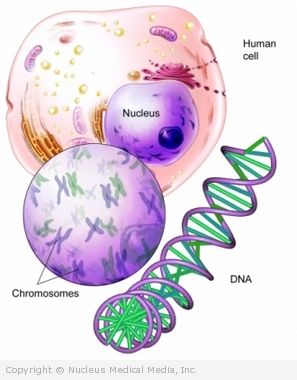von Willebrand Disease
von Willebrand disease – Definition
von Willebrand disease (vWD) is an inherited blood disorder. It decreases the blood’s ability to clot. As a result, bleeding lasts longer than usual.
von Willebrand’s disease is the most common hereditary bleeding disorder, affecting about 1% of the population. It affects both sexes approximately equally. There are no racial or ethnic associations with this disorder.
von Willebrand disease – Causes
vWD is caused by a reduced amount of a protein called von Willebrand factor (vWF) or an abnormality in this protein. This protein helps blood to clot. When a person is bleeding, blood cells called platelets form a plug to stop the bleeding. Normally, vWF allows platelets to adhere to the cells that line the inside of the blood vessels (endothelium), a process necessary for successful clotting. If there is not enough vWF or if it is defective, platelets cannot properly grip onto the injured area and bleeding does not stop as quickly as it should.
VWF has a separate function of protecting against the break down of another protein involved in clotting — factor VIII:C. The relative absence of functioning vWF, therefore, can lead to minor clotting problems through this mechanism as well.
von Willebrand disease can often be traced through several generations in a family. Some have symptoms, while others just carry the gene. Most people with vWD inherit only one gene with the vWD defect. They have one of the milder forms of the disorder — either type 1 or type 2. This means they have some blood clotting ability. The small percentage of people who inherit two defective genes — type 3 vWD — have little clotting ability and experience severe bleeding episodes.
Types 1 and 2 are usually inherited in what is known as a “dominant” pattern. A man or woman with the disease has a 50% chance of passing the gene to his or her child. This means that if even one parent has the gene and passes it to a child, the child gets the disease. Whether the child has no symptoms, mild symptoms, or, less commonly, severe symptoms, he or she definitely has the disease. Regardless of severity of the symptoms, the child can still pass the gene to his or her own offspring.
Type 3 von Willebrand disease, however, is usually inherited in a “recessive” pattern. This type occurs when the child inherits the gene from both parents. Even if both parents have mild or asymptomatic disease, their children are likely to be severely affected.
von Willebrand disease – Risk Factors
A risk factor is something that increases your chance of getting a disease or condition. The only risk factor for vWD is having family members with this disease.
von Willebrand disease – Symptoms
Many people with the vWD gene have very mild symptoms or none at all. When symptoms do occur, the severity varies from person-to-person. Many people only notice symptoms after taking aspirin or similar medications that interfere with clotting. Symptoms usually begin in childhood and fluctuate throughout life. Common symptoms include:
- Easy bruising
- Frequent or prolonged nosebleeds
- Prolonged bleeding from the gums and minor cuts
- Heavy or prolonged bleeding during menstrual periods
- Bleeding in the digestive system
- Prolonged bleeding after injury, childbirth, surgery, or invasive dental procedures
von Willebrand disease – Diagnosis
Your doctor will ask about your symptoms and medical history, and perform a physical exam. Blood tests may be done to check the following:
- Bleeding time — In vWD it will be prolonged, particularly after the administration of aspirin.
- Factor VIII antigen — This indirectly measures levels of vWF in your blood; in vWD, it will be reduced.
- Ristocetin cofactor activity — This shows how well your vWF works; in vWD, it will be decreased.
- von Willebrand factor multimer — This examines the different structural types of vWF in the blood; in vWD, it will be reduced.
von Willebrand disease – Treatment
Many people with vWD do not need treatment. If you do, your treatment will depend on the type and severity of your vWD. In many cases, treatment is only necessary if you are having a surgical or dental procedure that is likely to cause bleeding.
Treatment may include:
- Desmopressin — This medicine usually controls bleeding in mild cases of type I vWD by raising the level of vWF in the blood. It can be taken as:
- Nasal spray (Stimate)
- Injection (DDAVP)
- Intravenous infusions to control your bleeding — These infusions are concentrates that contain:
- Factor VIII
- von Willebrand Factor
- Birth control pills — This medication may be used to control heavy menstrual periods in women with type 1 vWD.
- Antifibrinolytic medicine (often Amicar) — This can be used for bleeding in the nose or mouth. It helps keep a clot that has already formed from being dissolved.
- Recominant Factor VIIIa — This treatment may rarely be used if a person develops antibodies to von Willebrand Factor.
von Willebrand disease – Prevention
There are no guidelines for preventing vWD. Genetic counseling can be helpful to review a detailed family history and discuss risks and tests available for von Willebrand disease.

